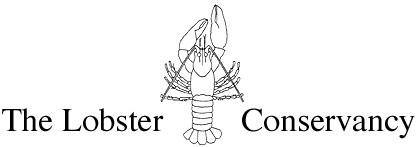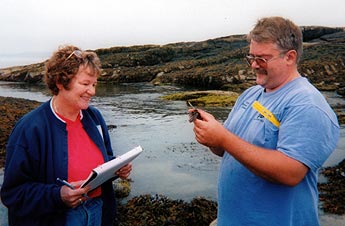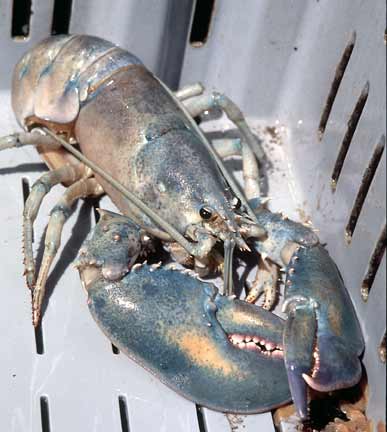
P.O. Box 235, Friendship, ME 04547 (207) 832-8224 www.lobsters.org

P.O. Box 235, Friendship, ME 04547 (207) 832-8224 www.lobsters.org
September, 2001
Dear Volunteers and Friends of The Lobster Conservancy,
For those of you who may be unfamiliar with The Lobster Conservancy, we are primarily a scientific research organization dedicated to sustaining a thriving lobster fishery through science and community. This newsletter keeps our friends and volunteer research team informed of our activities. Here’s what we’ve been up to over the past month.News from the Board of Directors
We are pleased to announce two recent grants to support TLC’s research on juvenile lobsters. The Boston Foundation is currently supporting the Juvenile Lobster Monitoring Program in Massachusetts. Up East Foundation has committed to support a comparative study on ecology and behavior of juvenile lobsters in the Gulf of Maine. This 3-year study will start in 2002, and will focus on 3 sentinel monitoring sites in Maine: Allen Island, Friendship Long Island, and Lowells Cove. The study is designed to offer insights into how factors such as water temperature, depth, and geographic location affect the abundance and behavior of juvenile lobster.
The Lobster Conservancy bids a fond farewell to summer interns Hilary Halstead and Pierson Stoecklein. Over the summer, Pierson and Hilary were involved in many aspects of The Lobster Conservancy. One of their projects was to compile maps of TLC’s juvenile lobster monitoring sites, to be used in reports to state planning agencies. They also built and deployed lobster shelters as part of the naturalistic habitat in the lobster pound at the Lobster Life Studies Center, and helped develop external tagging methods. Pierson and Hilary are now fully ensconced in classes back at Colgate University in Hampton, New York.
The Lobster Conservancy has moved to a spacious new office in downtown Waldoboro. We are now located at 25 Friendship Street, 2nd floor. We share the building with another non-profit organization, the Medomak Valley Land Trust (www.midcoast.com/~wpl/mvlt) which is dedicated to the permanent protection of local land for the benefit of the public and future generations. TLC’s mailing address and phone number remain unchanged.
Research News
Volunteer Program
In August, volunteers completed another round of sampling for juvenile lobsters throughout the Gulf of Maine. We now have more than 70 volunteers and 26 monitoring sites from Manomet Point, Massachusetts to Isle au Haut, Maine. There have been strong signs of settlement at many of the sites from Massachusetts to Muscongus Bay.
In Penobscot Bay, Sara conducted a site visitation with Kipp and David Quinby on Isle au Haut. They sampled 8 lobsters measuring 17 to 34 mm in carapace length (CL). On Vinalhaven, John van Ness and Sara found 6 lobsters in the rocky site (29-68 mm CL) and John managed to ferret out 5 more in the nearby eel grass bed (42-74 mm CL). In South Thomaston, Leslie Fuller and Annette Naegel found no lobsters along their transect and but captured 1 in random sampling (40 mm CL). In Port Clyde, Julie Wortman discovered 12 lobsters along her transect.
In Muscongus Bay, Gayle Stuart and Chris Harjula took 2 days to sample their productive lobster nursery at the North Beach of Allen Island. They found 31 lobsters (28-56 mm CL) (for more on Muscongus Bay see Long-term Tagging section below).
TLC has started up a new monitoring site in Sheepscot Bay, at Pratts Island in Southport, which was known to be a rich lobster nursery ground from earlier work by scientists at Maine Department of Marine Resources. Sara trained Joyce Armendaris and Dickie Bredeau, recent graduates of the inaugural class of Mid-Coast Marine Stewards, to start sampling at Pratts Island. All three of us were amazed at the number of tiny lobsters we found during the two training sessions as 5 of the 28 lobsters we found were smaller than 11 mm in carapace length.

TLC’s Juvenile Lobster Monitoring Program expanded its scope to include Pratt’s Island in Southport, Maine with the help of volunteers Joyce Armendaris and Dickie Bredeau. (Photo by Sara Ellis)
In Casco Bay, Sara filled in for Meg Warren at Potts Point with assistance from Bronda and Al Neisse. The Potts Point team found 10 lobsters (6-40 mm CL). New volunteers Henry Bird and Zach Soper started monitoring lobsters on Yarmouth Island at a site that was previously monitored by lobsterman Matt Waddle and his family. In July, Sara trained Henry and Zach how to find and measure lobsters, and in August they learned how to set up and sample a transect. Henry and Zach found 8 lobsters along their transect including a tiny recently-settled 9 mm CL lobster. In Cundys Harbor, Amy Watson and new volunteer Stacy Welner sampled 5 lobsters (6-35 mm CL) including 3 tiny settlers. Frank and Judy Haims discovered 14 lobsters (21-54 mm CL) at Gun Point. On Chebeague Island, Mac Passano, Beth Howe and Helen Chabot found 2 lobsters (32-42 mm CL). Lynne and Steve Richard found 8 lobsters (27-42 mm CL) at their site on Peaks Island. In Zeb Cove on Cape Elizabeth, Jack Ney and Jess Munro and Sara gathered data on 8 lobsters (21-50 mm CL). Mike Doan, Mary Cerullo, Josh Madeira and Tom O'Connor, TLC’s partners from Friends of Casco Bay, found 12 lobsters at Broad Cove (28-60 mm CL).
In Southern Maine, Enid and Pat White were perplexed to find only 2 lobsters (both 35 mm CL) at Lobster Cove, after having found 11 lobsters the month before.
In New Hampshire, John and Carolyn Payzant and Jumbo Jervis found 19 lobsters at Fort Stark (24-75 mm CL). At the tide pool in Odiorne Point State Park, Al Stewart and Barb Zulkiewicz uncovered 5 lobsters (24-41 mm CL). Brad Judkins and UNH Marine Docent Carol Spinney found 9 juveniles (29-51 mm CL) at TLC’s new monitoring site in Plaice Cove.
In Massachusetts, Pat Earle, Cindy Dunn and newcomer Barbara Warren found 25 lobsters at Plum Cove, 5 of which were < 10 mm CL. Sean Sullivan, Oddvar Solstad, Jack Arnold and Rod Thibodeau found an amazing 50 lobsters at their site in Marblehead, including the smallest they’ve ever seen (but the little devil got away!).
Long-term Tagging of Juvenile Lobsters
Diane Cowan continued her long-term tag-and-recapture studies of juvenile lobsters at Lowell Cove on Orr’s Island in Casco Bay and Deep Cove on Friendship Long Island in Muscongus Bay. In August she found more post-larvae and recently-settled lobsters than she’s ever seen in Friendship and a good many at Lowells Cove, too. Thanks go to Polly Wilson and Anne Barrett for help tracking lobsters at Lowells Cove where the sampling would have taken even more days without them.
Lobster Life Studies Center
Diane has been conducting pilot observational studies of lobster shelter use since Hilary and Pierson deployed the shelters in the pound. Thanks go to volunteer Linda Archambault who has been helping externally tag the lobsters so that they can be recognized by observers. The lobsters seem to be using the shelters in a different way from what Diane expected. They live in one shelter for several days, then move to another. She sees certain animals each day for a stretch of time, then they disappear and she sees different ones. More specific patterns of shelter use, such as differences between males and females or the influence of dominance, will emerge only after long-term census data have been collected.
We have started a collection of exotic lobsters thanks to the generosity of local folks. Friendship lobsterman Bubba Lee donated two beautiful blue lobsters — one male and one female. Chebeague lobsterman Bob Putnam donated a yellow male lobster as a potential mate for the stunning yellow female that Bubba Thompson donated earlier this year. Darryl and Amy Sue Brazier donated a very odd lobster, the likes of which Diane has never seen before. This one has some male and female characteristics on both sides. Other gynandromorphs we've seen — like the one Friendship lobsterman Gerry Lane donated last year — have paired structures with male characteristics on one side and female on the other. This lobster has male gonopores (where spermatophores are extruded at the base of the 5th pair of walking legs), but combined gonopods (first pair of pleopods — used by a male to transfer spermatophores to a female). The first pair of pleopods are calcified at the base of the abdomen where they attach to the lobster (as is normal for a male), but then they end in a feathery soft tip (as is normal for a female), thus the first pair of swimmerettes on both sides is half male and half female.
  Our thanks to local fishermen for the donation of unusual – and beautiful – lobsters such as these. (Photos by Joyce Morrill) |
|
Friendship lobstermen have been helping us out in other departments as well. Thank you to Gerry Lane for setting a new mooring out at the island, and to Marty Benner for help with our mainland mooring. Thanks also to Kevin Benner and Henry Thompson for building us new ladders for the LLSC wharf, and to the Fishermen’s Heritage Lobster Co-op for providing storage space on the mainland.
The LLSC is comprised of property and lobster pounds on Friendship Long Island and Little Morse Island. To date we have concentrated most of our efforts on Friendship Long Island since the lobster pound and house there are in working condition. The property on Little Morse Island however needs a little "TLC" in the traditional sense and volunteers from the Mid-Coast Marine Stewards Program helped give it just that. Thank you to Theresa Torrent-Ellis of the Maine State Planning Office and Bob Grant of TLC for organizing a clean-up day at Little Morse Island. Mid-Coast Marine Steward volunteers Alan Pooley, Pete and Carol Blanton, Charlie and Gail Kojigian, Dick Harris, and Susan Harvey teamed up with Theresa and Maine State Planning interns Ashely Atwood and Meagan McHold to help TLC work miracles at Little Morse Island. Dave Starr and George Cleaves provided manpower, a skiff, and a truck to remove debris from the island. Thank you to all for a very successful day!
There have been many other visitors to the LLSC this summer. Professor Joe Kunkel and undergraduate Ted Hontento of UMass Amherst visited the LLSC in August to plan behavioral and physiological research on lobsters’ response to stress. Carol White of the Chebeague Island Lobster Camp and her two daughters Anna and Julia delivered the yellow lobster donated by Bob Putnam.
Last year, the Alexander family of Orr’s Island generously donated Gene Alexander’s lobster boat, the Capt’n Zack to TLC. Over the summer Bob, Hilary, and Pierson took great pride in working on Capt’n Zack, and we launched her on August 3. Bob ceremoniously christened her with the bottle of champagne that Gene had been planning to use for this same purpose before he passed away. TLC plans to use this boat in our scientific and educational programs based at the LLSC.

Many thanks to the Alexander family of Orr’s Island for donating Gene’s lobster boat Capt’n Zack. (Photo by Sara Ellis)
Outreach and Education
The Lobster Life Studies Center serves not only as a site for scientific research but also for Outreach and Education. On August 9th, the LLSC hosted its third service-learning project for teenagers from Hurricane Island Outward Bound School. Students learned about lobster biology and research in exchange for doing maintenance work around the lobster pound.
Things are progressing well with our third service-learning project with undergraduate geology students at Bowdoin College. During the summer, Service Learning Coordinator Cathryn Field and interns Emily Scott and Kristen Kindsvogel mapped all of TLC’s lobster monitoring sites onto GIS base maps. The next step is for first-year geology students to examine these maps along with information on sediment type, bottom topography, tidal range, geographic location and other factors to try to tease out which factors influence abundance and distribution of juvenile lobsters. To recruit service-learning students, Sara gave a presentation to Ed Laine’s Marine Environmental Geology class on September 5, as did Erno Bonebakker from Return the Tides and Joe Payne from Friends of Casco Bay.
Media Coverage
In early August ARD German Television, based in Washington DC, came to the LLSC to do a story on lobsters and The Lobster Conservancy. They interviewed Diane and interns Hilary and Pierson for a show that is slated to air in September.
Events
Diane and Sara were privileged to be invited to the Seventh Annual Great Taste of Maine Lobster Governor's Tasting and Culinary Competition. The Maine Lobster Promotion Council sponsors the prestigious event, which is designed to showcase Maine lobster. Governor King, First Lady Mary Herman, and some 150 special guests from the lobster and restaurant industries sampled original recipes prepared by nine outstanding chefs from Maine restaurants. The theme for this year’s cooking competition was "Break for Brunch with Maine Lobster." To learn more about the annual event or receive copies of lobster recipes visit the MLPC web site (www.mainelobsterpromo.com/press.php).
Donations to TLC
Thank you to Michelle Langstaff of Waldoboro for donating a Compaq Presario desktop computer to TLC. Thanks also to Walter Foster of Friendship for donating a wetsuit for research at the LLSC, and to artist Alice Loomis of Friendship for a donation to help furnish our building on Little Morse Island.
Yours in TLC and Friendship,
Sara Ellis, Executive Director and Diane Cowan, Senior Scientist